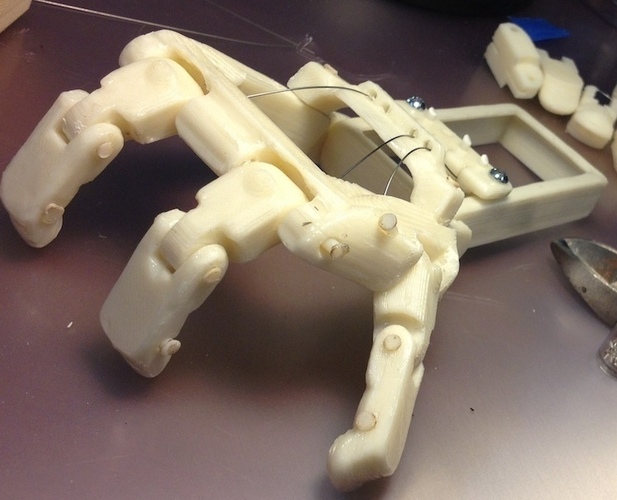
Ody Hand RP 1.0 (a Prosthetic Hand Research Platform)
pinshape
The Ody Hand RP 1.0 is a research platform that I used for my first e-NABLE experiments back in 2014. Our e-NABLE R & D teams at the MAGIC ACT Lab at R.I.T used it for developing experimental prosthetic hands for children born without fingers. The Ody Hand developed by Peter Binkley was chosen as a research platform because of its simplicity and rapid prototyping capabilities. I recommend that you download the new STL files uploaded by Peter Binkley on 10-18-18 and follow his instructions (Ody Hand). Experiment 1: Proof of concept for using 3mm printing filament for hinge pins and wire attachment posts. The Ody Hand RP 1.0 modifies the original Ody Hand designed by Peter Binkley to make it easy to print and assemble while eliminating features for attaching the hand to a user. The changes include using 3mm 3D printing filament for hinge pins, which are melted into buttons with a soldering gun to keep them from being removed. When the pins need to be removed, the buttons can be clipped off or drilled out. A 3Doodler hand-held 3D printer also works well for retaining the hinge pins by adding blobs on each end. 3mm filament was also used as attachment posts for wire ends in the finger tips and forearm. The wire channel is sized to accommodate the wire loop, and there are holes to accommodate short pieces of 3mm filament which can be held in place with blobs on the underside created with a 3Doodler like a glue gun. Results: Advantages of using 3mm filament include strength and slower, higher resolution settings required for good quality pins. Experiment 2: Proof of concept for using .5mm music wire as a flexor/extensor mechanism. Ody Hand RP 1.0 demonstrates the proof-of-concept for using .5mm music wire as a flexor/extensor mechanism in a prosthetic hand instead of plastic filament used in the normal Ody Hand. This is for research purposes only and should not be used on a prosthetic, especially for children, until considerable research has been done on potential failure modes where a pointed end may be exposed. The design attempts to address safety concerns by creating termination on the ends of the wire and attaching it to the device using needle-nosed pliers and crimping with little aluminum beads. Results: The push/pull wire tendons showed deformation during pushing, especially in the thumb, requiring extra wrist displacement, but its impact is unknown. Specific prosthetic devices may be able to take advantage of low friction by using channels or tubes to guide the wire like a bicycle hand break. Later experiments will evaluate pros and cons by taking physical measurements of forces on the platform. Note: Recent designs have evolved by Peter Binkley and Peregrine Hawthorn to successfully use Nylon filament as extensor/flexor tendons. See Osprey Hand.
With this file you will be able to print Ody Hand RP 1.0 (a Prosthetic Hand Research Platform) with your 3D printer. Click on the button and save the file on your computer to work, edit or customize your design. You can also find more 3D designs for printers on Ody Hand RP 1.0 (a Prosthetic Hand Research Platform).
